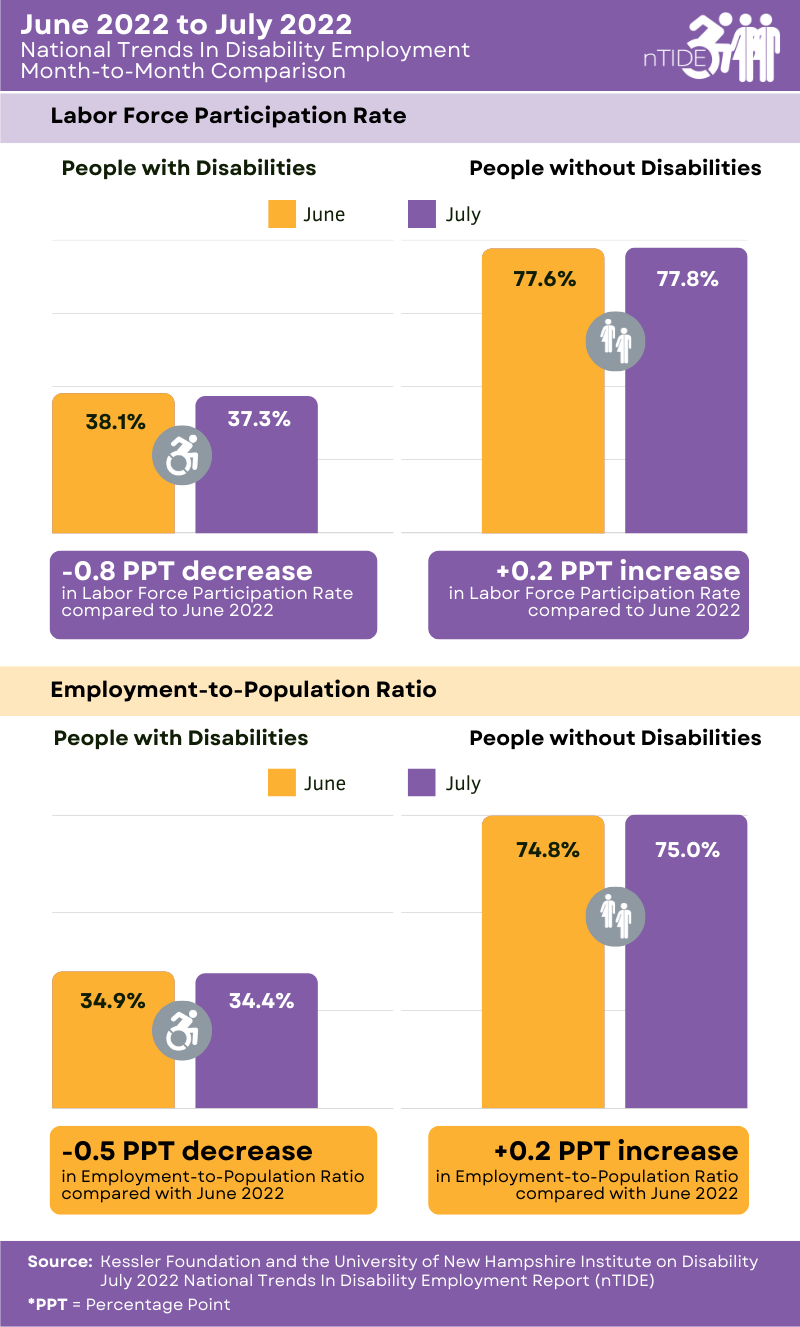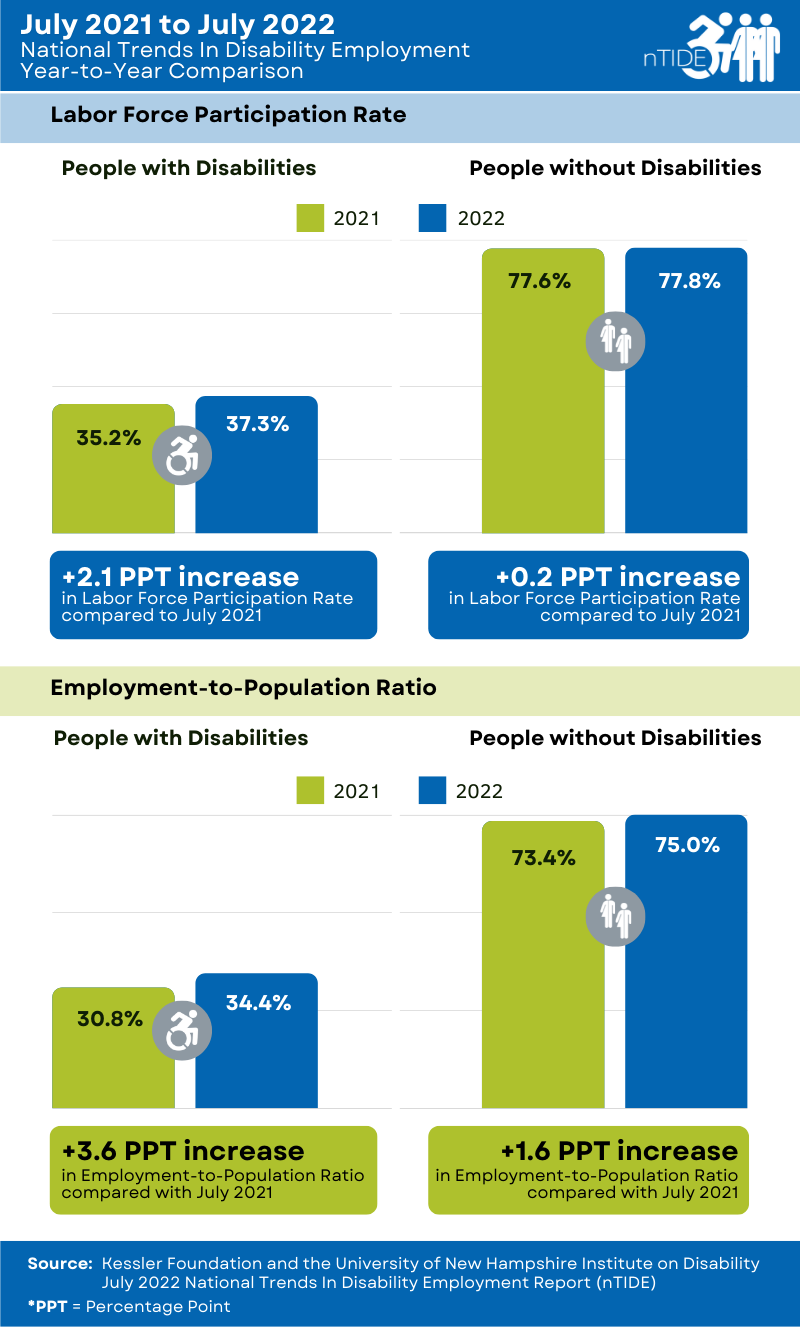National Trends in Disability Employment (nTIDE) – Issued semi-monthly by Kessler Foundation and the University of New Hampshire
East Hanover, NJ – August 5, 2022 – Employment remained high in July for people with disabilities, despite a dip in their economic indicators, according to today’s National Trends in Disability Employment – Monthly Update (nTIDE), issued by Kessler Foundation and the University of New Hampshire’s Institute on Disability (UNH-IOD). NTIDE experts caution that the gains achieved by people with disabilities may be tempered as counter-inflationary measures continue in the coming months.
Month-to-Month nTIDE Numbers (comparing June 2022 to July 2022)
In the U.S. Bureau of Labor Statistics (BLS) Jobs Report released today, the employment-to-population ratio for people with disabilities (ages 16-64) decreased from 34.9 percent in June 2022 to 34.4 percent in July 2022 (down 1.4 percent or 0.5 percentage points). For people without disabilities (ages 16-64), the employment-to-population ratio increased from 74.8 percent in June 2022 to 75.0 percent in July 2022 (up 0.3 percent or 0.2 percentage points). The employment-to-population ratio, a key indicator, reflects the percentage of people who are working relative to the total population (the number of people working divided by the number of people in the total population multiplied by 100).

“While the dip in the employment-to-population ratio for people with disabilities is concerning,” said John O’Neill, PhD, director of the Center for Employment and Disability Research at Kessler Foundation, “it still remains above pre-COVID levels and the historic high of 2008, a trend that we’ve seen for 11 months. These data suggest that sampling error may be a factor for this population.”
Findings were similar for July’s labor force participation rate. For people with disabilities (ages 16-64), the labor force participation rate decreased from 38.1 percent in June 2022 to 37.3 percent in July 2022 (down 2.1 percent or 0.8 percentage points). For people without disabilities, the labor force participation rate increased from 77.6 percent in June 2022 to 77.8 percent in July 2022 (up 0.3 percent or 0.2 percentage points). The labor force participation rate is the percentage of the population that is working, not working and on temporary layoff, or not working and actively looking for work.
“Even though people with disabilities largely remained in the labor force during the COVID-19 pandemic and their employment rebounded faster and stronger, we will be looking ahead to the coming recession to see how they 'fare', remarked Andrew Houtenville, PhD, professor of economics and the research director of the University of New Hampshire’s Institute on Disability.
Year-to-Year nTIDE Numbers (Comparing July 2021 to July 2022)
The employment-to-population ratio for people with disabilities (ages 16-64) increased from 30.8 percent in July 2021 to 34.4 percent in July 2022 (up 11.7 percent or 3.6 percentage points). For people without disabilities (ages 16-64), the employment-to-population ratio also increased from 73.4 percent in July 2021 to 75 percent in July 2022 (up 2.2 percent or 1.6 percentage points).

Similarly, the labor force participation rate for people with disabilities (ages 16-64) increased from 35.2 percent in July 2021 to 37.3 percent in July 2022 (up 6 percent or 2.1 percentage points). For people without disabilities (ages 16-64), the labor force participation rate also increased from 77.6 percent in July 2021 to 77.8 percent in July 2022 (up 0.3 percent or 0.2 percentage points).
In July 2022, among workers ages 16-64, the 5,618,000 workers with disabilities represented 3.8 percent of the total 148,733,000 workers in the U.S.
Each nTIDE release is followed by an nTIDE Lunch & Learn online webinar. This live broadcast, hosted via Zoom Webinar, offers attendees Q&A on the latest nTIDE findings, provides news and updates from the field, as well as invited panelists to discuss current disability-related findings and events. On August 5 at 12:00 pm Eastern, Meg O’Connell, CEO and founder of Global Disability Inclusion, and Wendi Safstrom, president of SHRM Foundation, join Drs. Houtenville and O’Neill, and Denise Rozell, Policy Strategist at Association of University Centers on Disabilities (AUCD). Join our Lunch & Learns live or visit the nTIDE archives at: ResearchonDisability.org/nTIDE.
nTIDE COVID Update
Join us on August 19, at 12:00 pm Eastern for the mid-month COVID update – an in-depth comparison of the latest unemployment numbers for people with and without disabilities. Register at: COVID-19 Updates - 2022 | Center for Research on Disability.
NOTE: The statistics in the nTIDE are based on Bureau of Labor Statistics numbers but are not identical. They are customized by UNH to combine the statistics for men and women of working age (16 to 64). nTIDE is funded, in part, by grants from the National Institute on Disability, Independent Living and Rehabilitation Research (NIDILRR) (90RT5037) and Kessler Foundation.
About the Institute on Disability at the University of New Hampshire
The Institute on Disability (IOD) at the University of New Hampshire (UNH) was established in 1987 to provide a university-based focus for the improvement of knowledge, policies, and practices related to the lives of persons with disabilities and their families. For information on the NIDILRR-funded Research and Training Center on Disability Statistics, visit ResearchOnDisability.org.
About Kessler Foundation
Kessler Foundation, a major nonprofit organization in the field of disability, is a global leader in rehabilitation research that seeks to improve cognition, mobility, and long-term outcomes – including employment -- for people with neurological disabilities caused by diseases and injuries of the brain and spinal cord. Kessler Foundation leads the nation in funding innovative programs that expand opportunities for employment for people with disabilities.